You’ve just started settling on the island of Catan. Cities are popping up everywhere, with thriving communities and abundant resources, but there’s just one problem: an invasion is on the horizon. Barbarian ships are approaching the shore!
Can you protect your beloved island? That is the ultimate question in Catan: Cities and Knights, the best expansion pack for players who relish a challenge.
If you’re anything like me, you’ll be thrilled by the opportunity to beat your friends and the Barbarian invaders who threaten Catan all at once, making victory taste even sweeter.
You’ll have to face added tactical complexity to emerge triumphant thanks to the introduction of invaders, knights, and new commodities, but I know you can do it – in fact, I’ll even offer you some handy tips straight from the pro (me) if you keep reading. (You’re welcome.)
So, stick with me to find out all the must-know information about Catan: Cities and Knights, including the idea behind the original game, how to use the expansion pack, and so much more.
Catan: Cities and Knights – an Overview
- Players – 3-4
- Recommended age – 12+
- Playing time – 90-120 minutes
Catan: Cities and Knights is a great expansion pack for players who want to add an extra dimension of realism to their game. It allows cities to be built and developed faster thanks to activities like mining and irrigation, as well as the addition of commodities like coins, cloth, and paper.
However, such a thriving civilization is sure to come under attack from envious invaders, which is where knights come in; they can be used to attack and defend Catan.
To use the Cities and Knights expansion pack, you’ll need to have the original base game. Find out more in our Catan game guide.
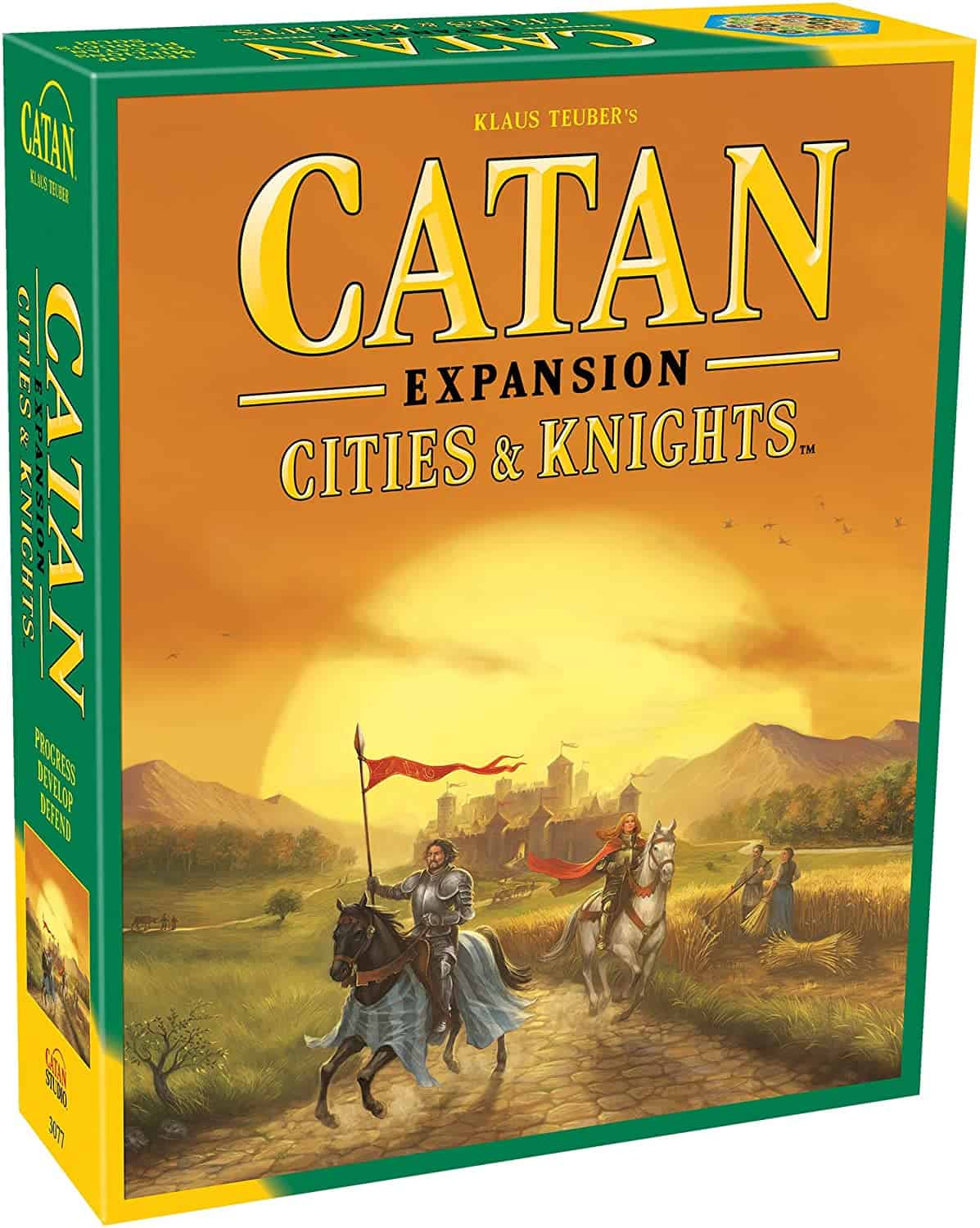
The History and Origins of Catan
For anyone who isn’t already familiar with the game (where have you been for the past decade?!), Settlers of Catan – now known simply as Catan – is a multi-player board game designed by Klaus Teuber that was first published in Germany in 1995.
Catan is renowned for being one of the first German-style board games to achieve popularity outside Europe; in fact, today, the game is a worldwide phenomenon, with well over 30 million copies being sold – a number that’s practically unheard of in the world of board games.
Why is Catan so successful? Nobody can say for certain, but it likely has something to do with the fact that the game taps into the human desire to build, travel, innovate, and expand into new places.
Fortunately for us couch potatoes, all of that exploring and civilization-building can be done from the comfort of our bedrooms. Phew!
There have been a number of variants, extensions, accessories, and expansions released over the years, showing just how versatile and complex the game can be. These include:
Catan: Seafarers was the first expansion pack to be released in 1997. Cities and Knights came out the following year, in 1998.
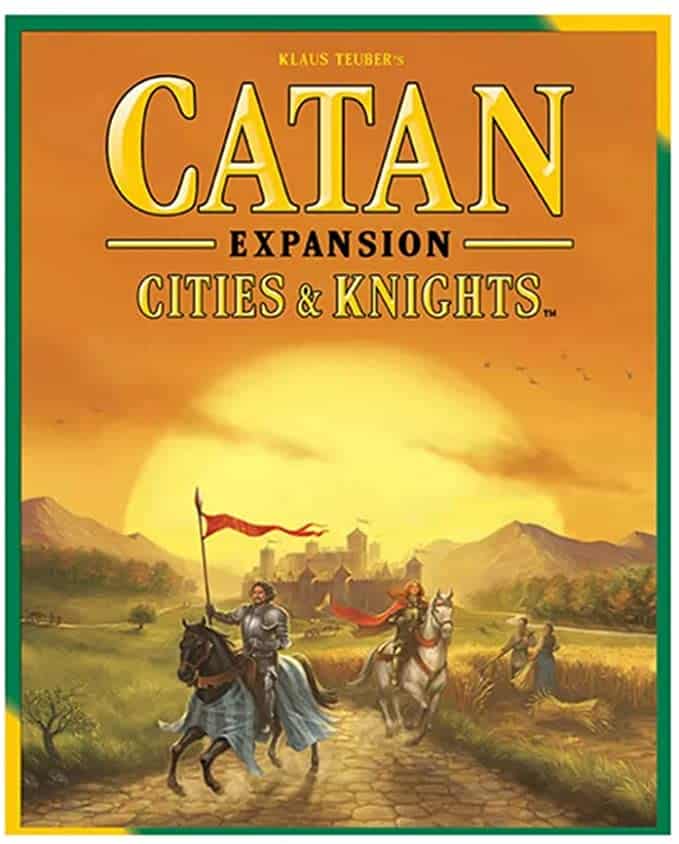
The Difference between Cities and Knights Expansion and Catan
Here are some key differences you should be aware of between the original Catan and the Cities and Knights expansion pack.
- 10 victory points are required to win Catan; 13 are needed to win Cities and Knights
- Catan’s Development Cards are replaced by Progress Cards
- The information on Catan’s Building Cost Cards is provided by the City Upgrade Calendar
- The “Largest Army” Card holds less importance in the expansion pack; it does not directly earn victory points
Knights
Before you play the expansion pack, you need to label all twenty-four knight tokens. There are six tokens of each color.
Each player needs:
- 2x basic knights
- 2x strong knights
- 2x mighty knights
Development Flip-Chart
The spiral-bound pages of the Development flip charts need to be separated. You use these charts to track city improvements; when you buy a city improvement, you flip the page section that matches the improvement.
The red fice depicted on each page section tells you whether you acquired any Progress Cards, and the third level of improvement in each category shows the special ability you have earned for that particular development track.
City Walls
City walls are another new feature. They are wooden blocks that you can position beneath your cities; each wall you have on the board increases the number of cards you can safely hold in your hand when a seven is rolled on the production dice.
If you want to build a city wall, you’ll need to pay two brick resources to the bank. Each wall adds two cards to your safe hand limit.
It’s important to note, however, that you can’t place a city wall under a settlement. Also, you can have three walls at most on the board at any one time.
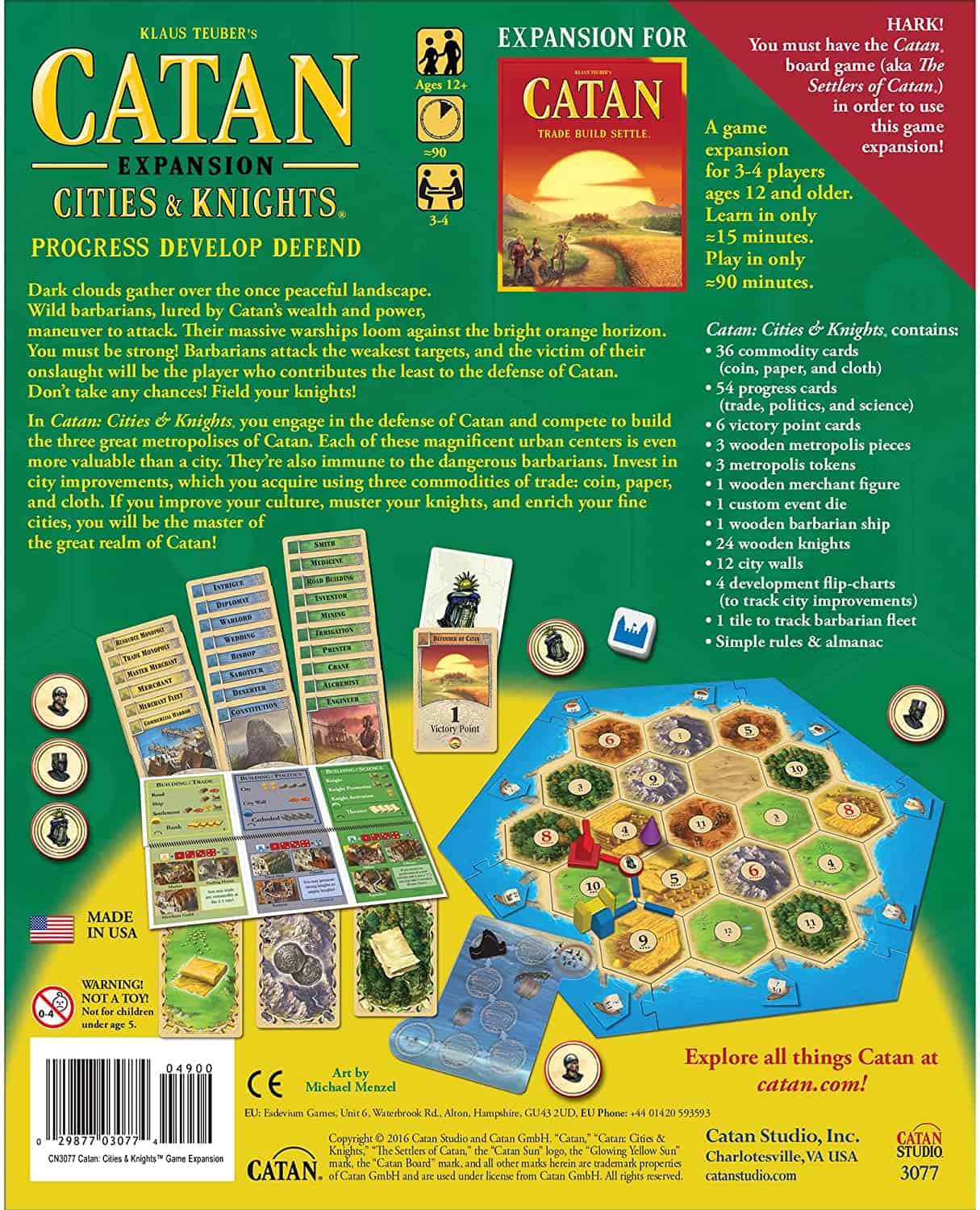
How to Play
Before you start playing, you’ll need to spend a bit of time setting up the game.
Setup
- Sort the Resource cards into five stacks (one for each resource) and place them face up near the island
- Sort the Commodity cards into three stacks and place them face up near the Resource cards
- Divide the Progress Cards into three stacks by the flag color on the back of each card and place them face down near the island
- Place the three metropolises, the trader cone, the three dice, and the “Longest Road” card near the island.
- Next, put the wooden ship on the “Barbarian Ship” space
- Place the robber on the desert hex
- Each player needs to select a color and collect all pieces of that color
Each player receives:
- 5x settlements
- 4x cities
- 15x roads
- 6x knights
- 3x city walls
- 1x development flip-chart
Setup Phase
Each player rolls the red and yellow dice; the person who rolls the highest number takes the first turn. Next, each player puts one settlement and one road on the board.
The second building round begins with the last player placing a settlement. Now, each player places one city and one road, following the regular rules set out in the original Catan instructions (find out how to play in this guide).
As soon as you place your first city, you receive resources – one for each terrain that your city is adjacent to.
Put your development flip-chart in front of you with the first-page showing.
Taking a Turn
Play travels in a clockwise direction. Each turn, players must:
- Roll all three dice
- Resolve the results of the Event (symbol) die
- Progress Cards may be drawn
- Check the red and yellow dice to find out what resources need to be produced by players
- The red and yellow dice also show the commodities that need to be produced
You can do any or all of the following:
- Trade resources
- Build settlements, cities, knights, roads, city walls, and/or city improvements
- Play Progress Cards
- Activate your knights, promote them and/or perform actions with them

Dice Rolls
- First of all, use the white Event die to determine what Event takes place that turn. If the ship symbol is showing, move the Barbarian Ship one space closer to Catan (the Barbarians attack when it reaches the final space).
- If the Event die shows one of the three city gate symbols, then all players might be eligible to draw a Progress Card. To do so, they would need to match one of the red die icons shown on their flip chart with the number rolled on the red die.
- Add the red and yellow dice together to determine which hexes produce resources and commodities. All hexes with a number that matches this sum produce one of the appropriate resources for each adjacent settlement.
Game Rules
Below are the rules you need to be aware of when playing with the Cities and Knights expansion pack.
Trading & Building
You can trade and build any number of times and in whichever order you choose. You don’t have to finish your trading before you finish your building. All rules from the original game apply to trades made in Cities and Knights.
City Walls
To build a city wall, you’ll need to pay two brick resources. This is because you can only build walls under cities, and if the Barbarians pillage your city, the wall is also destroyed.
As mentioned earlier, you can never have more than three city walls at any time.
Knights
Each knight is labeled on both sides, one side being active and the other inactive. An inactive knight can’t perform any actions.
To hire a knight, you’ll need to pay the bank with one wool and one ore. You can then take a basic knight and place it on the board with its inactive side up. It can be placed on any unoccupied intersection connected to your roads.
Once you have a knight, you can make two special purchases:
- Activating a knight (pay one grain)
- Promoting a knight (pay one wool and one ore)
You can promote a basic knight to a strong knight or a strong knight to a mighty night, both cost the same.
However, you can only promote a strong knight to a mighty knight after you have purchased the third-level politics (blue) city improvement.
Playing Progress Cards
After you have rolled the dice, you can play any number of Progress Cards in any order. When you play a Progress Card, resolve all of its effects and place it face up under the progress stack of the matching color.
Commodities
There are three new commodities in this expansion pack: cloth, coin, and paper. You can trade:
- Four of the same commodity for one of any commodity or resource
- Four of any resource for one of any commodity
You need commodities to acquire city improvements.
City Improvements
City improvements are tracked in your flipbook. You can improve in three key areas:
- Trade (yellow)
- Politics (blue)
- Science (green)
These improvements are represented by important buildings you can construct in your cities, such as a library or cathedral.
The first improvement of any type always costs one commodity of the matching type; each improvement subsequently increases by one commodity.
The Metropolis
To develop a metropolis, you’ll need to build city improvements first. However, only three metropolises (one each for politics, trade, and science) can exist in the game at any time. The first player to achieve the fourth level of improvement in these areas may build a metropolis.
A city with a metropolis is worth four victory points.
You can take another player’s metropolis if you manage to achieve the fifth level of improvement. Once you reach the fifth level of improvement, nobody can take your metropolis away.
Progress Cards
Progress Cards replace the Development Cards of the original Catan. To draw a progress card:
- You need to possess at least one level of city improvement in one or more areas of development
- The white Event die must show the city gate symbol whose color matches the color of one of your city improvements
- The number on the red die must match one of the red dice displayed on your city improvement whose color matches the city gate on the Event die.
Moving a Knight
You can move an active knight to another intersection. However, in order for this to happen, you must have built roads linking the intersections.
An intersection may only have one knight at a time. After the knight moves, he becomes inactive.
Displacing a Knight
When it’s your turn, you may move one of your active knights to an intersection that’s occupied by the knight of an opponent, but you can only do so if your knight is stronger than theirs. This is called displacing a knight.
The owner of the displaced knight has to move him to an empty intersection that is connected to the intersection from which he has been displaced by roads of his color. If there is no suitable intersection, the knight is removed from the board.
Chasing Away the Robber
Regardless of his strength, any knight can be used to chase away the robber. However, a knight may only do this if the robber is in one of the three adjacent hexes.
When you chase the robber, move him to a numbered hex of your choice. Then, steal a resource from the player who has a settlement or city adjacent to that hex.
Attack of the Barbarians
Whenever the Event die shows a black ship, the Barbarian navy moves one space closer to the island of Catan. When the Barbarians reach the island and attack, follow these steps:
- Determine the Barbarian strength – this is equal to the number of cities that all players own
- Determine the strength of Catan’s knights – counting only active knights, add up their strengths (one for basic, two for strong, three for mighty)
- Compare the strengths of the attackers and defenders
If the Barbarians are stronger, they win! They will pillage one or more cities, reducing them to settlements.
The Barbarians pillage a city that belongs to the player with the lowest total strength of active knights. If multiple players share the lowest number, both lose a city.
If the knights have a total strength equal to or greater than that of the Barbarians, Catan is saved! The player with the highest total strength of active knights is declared the “Defender of Catan” and is awarded one of the six Victory Point Cards.
Regardless of the outcome, the Barbarian ship returns to its starting position after the attack.
Losing Your Last City
If you lose your last city during an attack, you can keep any city improvements you built before the attack. You can also keep your Progress Cards, but you can’t build any additional improvements until you have built at least one city.
The Merchant
The Merchant figure (cone) comes into play when a player uses one of the Merchant Progress Cards.
You can place the Merchant on any land hex adjacent to one of your cities or settlements. You may trade the resource (not the commodity) that is produced in the land hex at a 2:1 rate until another card of this type is played.
If another Merchant Card is played, the person who played it takes control of the Merchant.
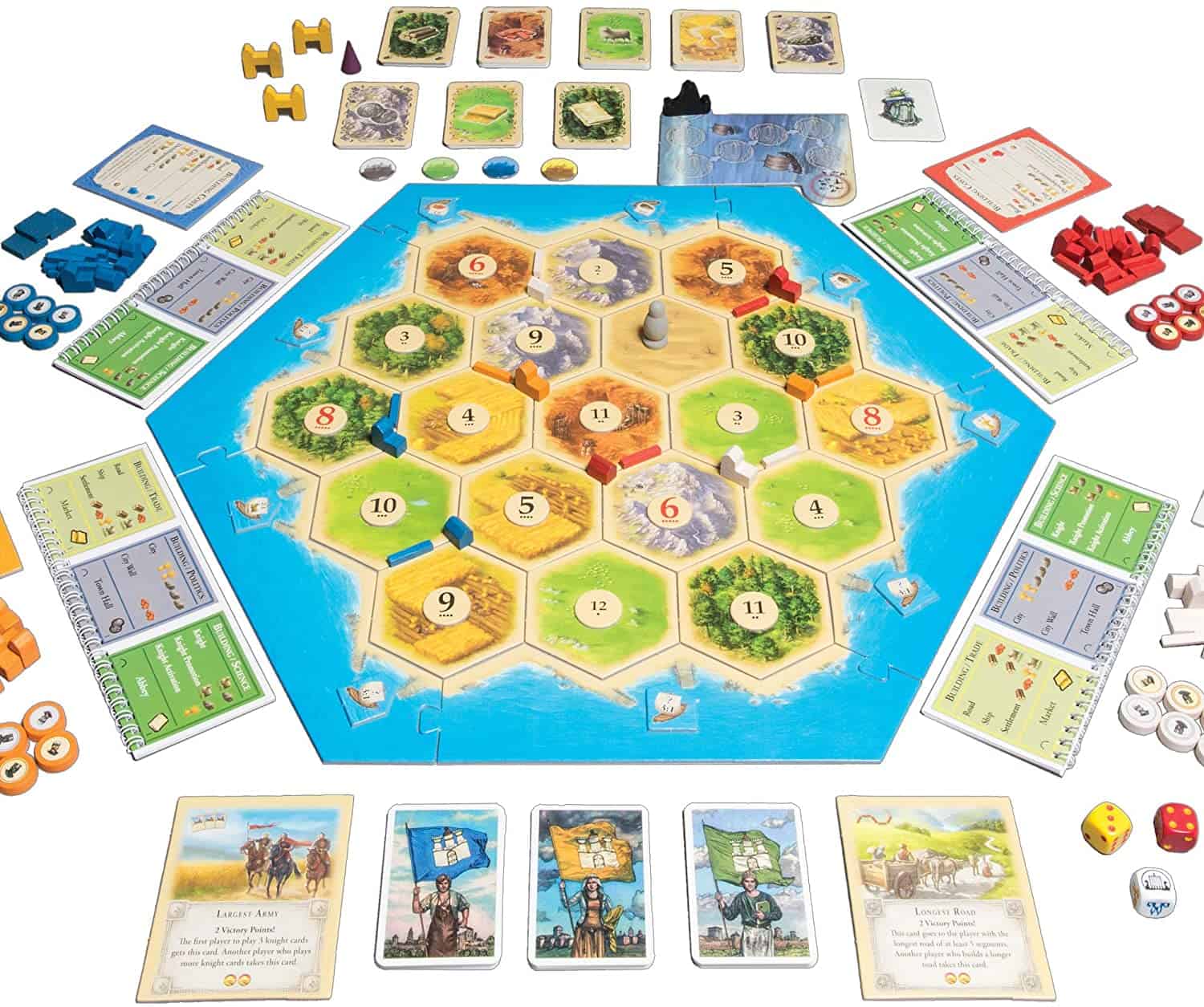
Ending the Game
The first player to reach thirteen victory points immediately wins the game. This player earns the title “Lord of all Catan.”
Who Is Catan: Cities and Knights for?
Catan: Cities and Knights are recommended for three to four players aged twelve and above. It is an excellent family game that can provide hours of fun, and each game is different, so you won’t get bored!
If that age range is a little too high for you, we also have a guide to the best games for four year olds and the best games for five-year-olds.
How Many Pieces Are There in Catan: Cities and Knights
These components are included in the expansion pack:
- 1x Barbarian tile with movement spaces
- 36x Commodity Cards (12x paper, 12x cloth, 12x coin)
- 54x Progress Cards (18x science, 18x politics, 18x trade)
- 6x “Defender of Catan” Victory Point Cards
- 4x Development flip-charts (aka city calendars)
- Playing pieces in 4 colors (12x city walls, 24x knights)
- 3x metropolis pieces
- 2x sheets of knight labels
- 1x Barbarian ship
- 1x Merchant
- 1x Game rules and almanac booklet
- 1x Game overview
- 1x Event die

Catan: Cities and Knights Alternatives
Here are some other Catan games I’d recommend.
Catan: Settlers of America
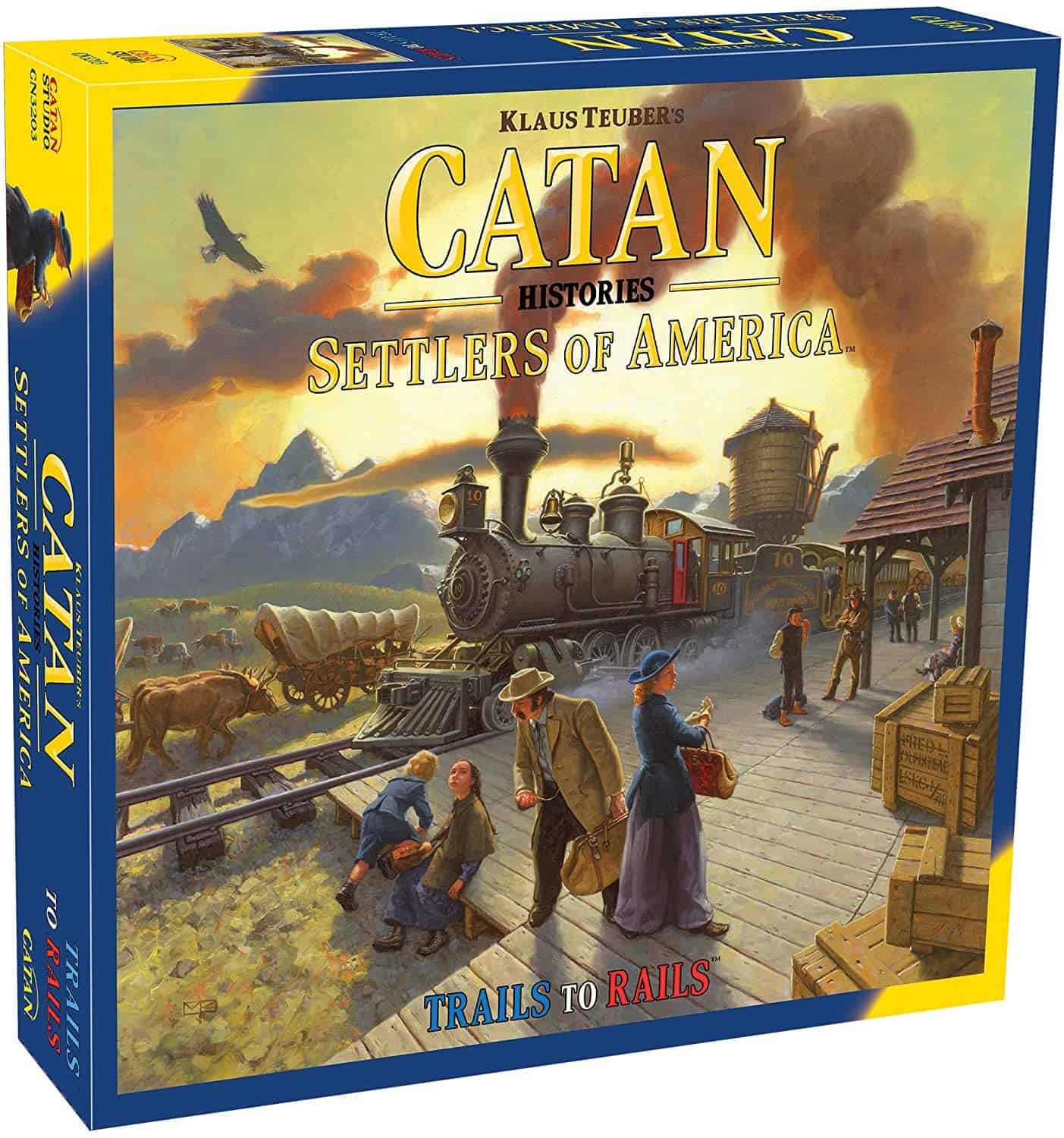
Settlers of America isn’t an expansion pack, it’s actually a spin-off game, but it’s worth trying for any die-hard Catan fans out there – especially those with an interest in American history and the impressive expansion of the nation via railroads that was achieved by early pioneers.
Find out more in our Catan: Settlers of America board game guide.
- Players – 3-4
- Recommended age – 12+
- Playing time – 120 minutes
Catan Junior
The only problem with recommending Catan as a family board game is the fact that it can be too complex for young children to enjoy. Fortunately, the creators of Catan have thought of everything, creating a junior version of the game.
Read our Catan Junior guide to find out how to play.
- Players – 2-4
- Recommended age – 6+
- Playing time – 30 minutes

Catan Dice Game
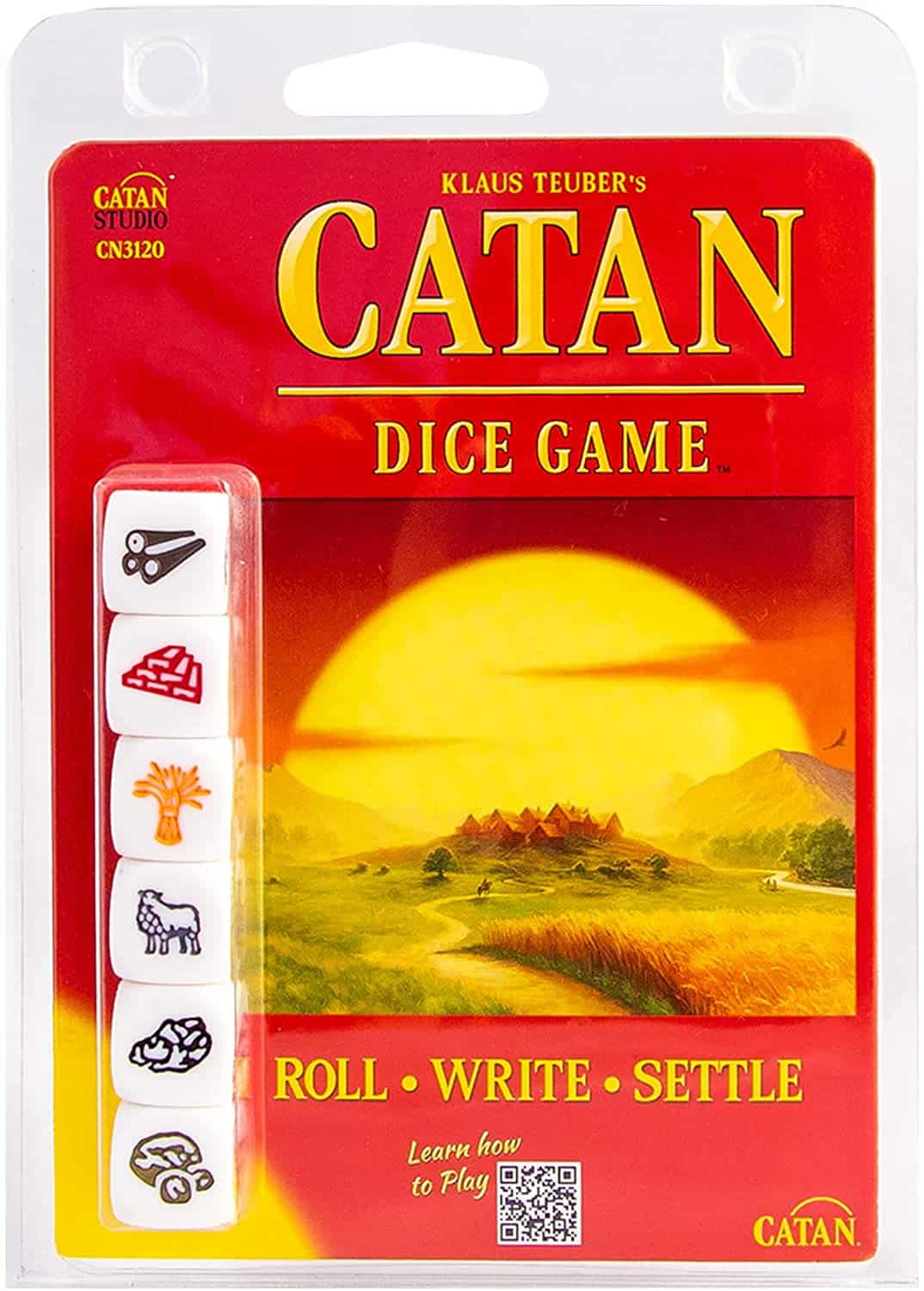
Catan Dice Game is a compact, travel-friendly version of the original game. Your goal is still to build settlements and cities, but rather than playing on a complex board with lots of additional components, the game simply comes with six dice and a scoreboard.
Want to learn more? Check out our Catan Dice Game guide.
- Players – 1-4
- Recommended age – 10+
- Playing time – 20-40 minutes
Frequently Asked Questions
Question: Can I play Catan: Cities and Knights solo?
Answer: Unfortunately not. If you consider yourself a social recluse, you’ll have to go to the effort of finding at least one other player (it’ll be worth it, I promise!).
Don’t have any friends to play with? Don’t be sad – check out our guide to the best solo board games.
Question: Where can I buy Catan: Cities and Knights?
Answer: You can purchase the game from Amazon here.
Question: Can I play Catan: Cities and Knights with more than four people?
Answer: If you’re lucky and have more than three friends to play with, you’ll be pleased to hear there’s an expansion pack that allows you to play Cities and Knights with up to six people. You can buy it here.
Question: What’s the best Catan expansion pack?
Answer: My personal favorite is Catan: Settlers of America, but that’s just because I’m a bit of a history nerd. It’s definitely worth exploring the whole range before choosing which one to buy. You’re in luck – here’s a guide to the best Catan expansion packs that we made earlier.
Question: Is Catan: Cities and Knights a family game?
Answer: It certainly is! In fact, it’s one of the best. If you’re looking for similar games, don’t forget to check out our guide to the best family games while you’re here.
Question: Can I still activate knights the moment the Barbarian ship reaches the coast?
Answer: Sadly not; the battle begins immediately.
Recommended Reads:
- Stratego Pieces Explained – Must-Know Facts - February 28, 2023
- Wahoo Board Game Guide – AKA Aggravation Guide - February 22, 2023
- Pokemon Monopoly Guide - February 22, 2023

